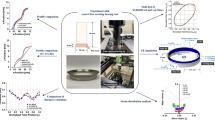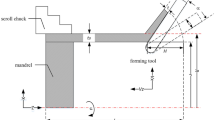Abstract
Incremental profile forming (IPF) is a new plastic processing technology developed in recent years. The new profile manufacturing technology is mainly used to produce tubular parts with variable cross sections along the axis of tube. The parts with different cross sections produced by this technology satisfy the lightweight and high strength requirements of the tubular parts. The IPF method is very flexible and can form diverse complex-shaped parts. Because no special machine is available for this technology, depending on the shapes of formed tubular parts, the forming tool and forming method should be designed. Thus, this study proposes a new method to form the annular groove and tube wall groove. Using a special tool and servo drive system of spinning machine, it is possible to form an annular groove and tube wall groove on the surface of tubular part. This is a typical IPF method for tubes. The process of different grooves on the surface of tubes was systematically studied in this paper. Through experiments and finite element simulations, different process parameters influencing the forming quality of groove were studied. It was concluded that the tool’s single feed and spindle speed significantly affect the forming quality and forming limit.
Similar content being viewed by others
References
Kroll L, Blau P, Wabner M, Frieß U, Eulitz J, Klärner M (2011) Lightweight components for energy-efficient machine tools. CIRP J Manuf Sci Technol 4(2):148–160
Kleiner M, Geiger M, Klaus A (2003) Manufacturing of lightweight components by metal forming. CIRP Ann Manuf Technol 52(2):521–542
El-Aty AA, Xu Y, Guo X, Zhang S, Ma Y, Chen D (2018) Strengthening mechanisms, deformation behavior, and anisotropic mechanical properties of Al-Li alloys: a review. J Adv Res 10:49–67
Lang LH, Wang ZR, Kang DC, Yuan SJ, Zhang SH, Danckert J (2004) Hydroforming highlights: sheet hydroforming and tube hydroforming. J Mater Process Technol 151(1–3):165–177
Dohmann F, Hartl C (1996) Hydroforming - a method to manufacture light-weight parts. J Mater Process Technol 60(1–4):669–676
Staupendahl D, Becker C, Weinrich A, Hermes M, Tekkaya AE (2012) Innovative Umformverfahren für Rohre, Profile und Bleche aus modernen Stahlwerkstoffen. Stahl Eisen 132(8):47–54
Becker C, Staupendahl D, Hermes M, Chatti S, Tekkaya AE (2012) Incremental tube forming and torque superposed spatial bending - a view on process parameters. special edition, pp 415–418
Becker C, Tekkaya AE, Kleiner M (2014) Fundamentals of the incremental tube forming process. CIRP Ann Manuf Technol 63(1):253–256
Rotarescu MI (1995) A theoretical analysis of tube spinning using balls. J Mater Process Technol 54(1–4):224–229
Hua FA, Yang YS, Zhang YN, Guo MH, Guo DY, Tong WH (2005) Three-dimensional finite element analysis of tube spinning. J Mater Process Technol 168(1):68–74
Grzancic G, Hiegemann L, Khalifa NB (2017) Investigation of new tool design for incremental profile forming. Procedia Eng 207:1767–1772
Grzancic G, Becker C, Khalifa NB, Tekkaya AE (2015) Basic investigations in incremental profile forming [C]// ASME International Manufacturing Science and Engineering Conference. American Society of Mechanical Engineers
Kim YH, Park JJ (2002) Effect of process parameters on formability in incremental forming of sheet metal. J Mater Process Technol 130-131(4):42–46
Xu DK, Lu B, Cao TT, Zhang H, Chen J, Long H (2016) Enhancement of process capabilities in electrically-assisted double sided incremental forming. Mater Des 92:268–280
Vasilikis D, Karamanos SA (2009) Stability of confined thin-walled steel cylinders under external pressure. Int J Mech Sci 51(1):21–32
Hashemi R, Faraji G, Abrinia K, Dizaji AF (2010) Application of the hydroforming strain- and stress-limit diagrams to predict necking in metal bellows forming process. Int J Adv Manuf Technol 46(5–8):551–561
El-Sawy KM (2001) Inelastic stability of tightly fitted cylindrical liners subjected to external uniform pressure. Thin-Walled Struct 39(9):731–744
Funding
This study was supported by the Fundamental Research Funds for the Central Universities (Grant No. NS2016059).
Author information
Authors and Affiliations
Corresponding author
Rights and permissions
About this article
Cite this article
Guo, X., Wang, C., Xu, Y. et al. Incremental forming characteristics of hollow parts with grooves. Int J Adv Manuf Technol 102, 829–837 (2019). https://doi.org/10.1007/s00170-018-3201-5
Received:
Accepted:
Published:
Issue Date:
DOI: https://doi.org/10.1007/s00170-018-3201-5




